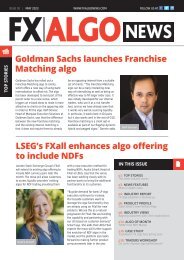You also want an ePaper? Increase the reach of your titles
YUMPU automatically turns print PDFs into web optimized ePapers that Google loves.
Next generation FX analytics: Bringing transparency and more to the FX execution process<br />
“TCA in combination with LPA gives a much more holistic<br />
view on the trade performance of counterparties.”<br />
volatility. Stakeholders have long been<br />
interested in leveraging execution data<br />
to dig deeper into them.<br />
there is no guarantee that another<br />
McGrath believes the pieces are in<br />
LP would have filled them, especially<br />
place for firms to break down this<br />
in a volatile environment,” he says.<br />
opacity. “Cost chains are complex,<br />
“However, reject ratios, response<br />
but with advanced data collation and<br />
time and spread analysis can be easily<br />
a deep understanding of customer<br />
measured. It has traditionally been the<br />
workflow, we can now start to address<br />
role of the Liquidity Manager to look<br />
these underlying components across<br />
at these numbers in a holistic way and<br />
the whole trade process,” he says.<br />
make some sense of them.”<br />
He explains that BidFX developed a<br />
“Best Value” suite to allow the buyside<br />
“A low fill ratio doesn’t immediately<br />
to factor in costs in real-time. “This has<br />
TRADING OPERATIONS<br />
John McGrath<br />
clients the ability to start evaluating<br />
their counterpart selection based on<br />
the wealth of data we could provide<br />
whether that be average LP spreads,<br />
skews, TOB, and market impact,”<br />
he says. “I wouldn’t say people are<br />
moving away from TCA. More that<br />
in combination with LPA, it gives a<br />
much more holistic view on the trade<br />
performance of counterparties. Clients<br />
now want to be able to affect their LP<br />
selection in flight based on a feedback<br />
loop on their LPA.”<br />
Lambert agrees with McGrath’s views.<br />
“At present, there is still plenty of<br />
analysis to be done in the TCA space,”<br />
he says. “The key to getting the best<br />
outcome is to use all the relevant<br />
information, and we believe that<br />
does indeed mean using live analytics<br />
around LPA, but it is still important to<br />
understand how trading choices have<br />
performed historically and how the<br />
method of execution was affected by<br />
the conditions in the market.”<br />
Meanwhile, Paul Liew, Head of<br />
Liquidity Management at TradAir, an<br />
ION company, notes that quantitative<br />
metrics are giving traders a great<br />
view on the execution impact of<br />
their decisions. “It’s difficult to put a<br />
monetary cost on rejected orders as<br />
mean that an LP is problematic,<br />
when the orders arrive only at the<br />
last minute just before the quote<br />
is refreshed. TCA will still be an<br />
important tool as PnL impact is more<br />
easily calculated.”<br />
Shevelenko thinks the utility of LPA<br />
analytics is high enough for firms to<br />
demand them as default parameters<br />
in execution platforms, something<br />
Bloomberg is acting on. “Recently,<br />
Bloomberg released a new suite of<br />
FX pricing quality tools that allow<br />
price takers to investigate how often<br />
a counterparty priced and won<br />
the trade, were runner up with the<br />
“Best Alternative” price or placed<br />
somewhere in the pack,” he says.<br />
“Price takers can also measure how<br />
often a counterparty declined to<br />
price, failed to pick up the request, or<br />
rejected a request to deal. Using the<br />
same analytical toolkit, price makers<br />
can quickly identify when clients<br />
traded away, or where opportunities<br />
to price are being missed and<br />
why, such as issues with internal<br />
counterparty setup, enablement<br />
issues, or internal credit rejects.”<br />
REMOVING OPACITY IN<br />
EXECUTION COST CHAINS<br />
FX execution cost chains have plenty<br />
of hidden costs within them, especially<br />
when evaluating the impact of<br />
counterparty liquidity and market<br />
now been developed to allow clients<br />
to start planning how they factor in<br />
counterparty selection to the trade<br />
process via a feedback loop.”<br />
Shevelenko echoes these views.<br />
“FX execution workflow resembles<br />
a conveyor belt where orders are<br />
moving through various stages such<br />
as creation, validation, compliance<br />
checks, eligible counterparty<br />
assignments, netting, and<br />
optimization,” he says. “Aggregated<br />
analysis over a representative<br />
timeframe could suggest various<br />
actionable enhancements to the<br />
workflow and trading process.”<br />
Hopkins offers a few examples of<br />
the questions execution analytics can<br />
answer now. “What is the economic<br />
impact of a valued counterparty<br />
terminating a relationship?,” he says.<br />
“How much does it cost to establish<br />
a relationship that is capable of filling<br />
the gap? Which liquidity providers<br />
should a firm be trading with? These<br />
are questions that firms have been<br />
wrestling with since trading began, but<br />
only now are technologies emerging<br />
that can start to help firms answer<br />
them on a systematic basis.”<br />
New Change FX’s Lambert cautions<br />
that examining the context behind<br />
the data is critical. “By providing the<br />
ability to capture, analyse and store<br />
28 NOVEMBER 20<strong>23</strong> e-FOREX
















